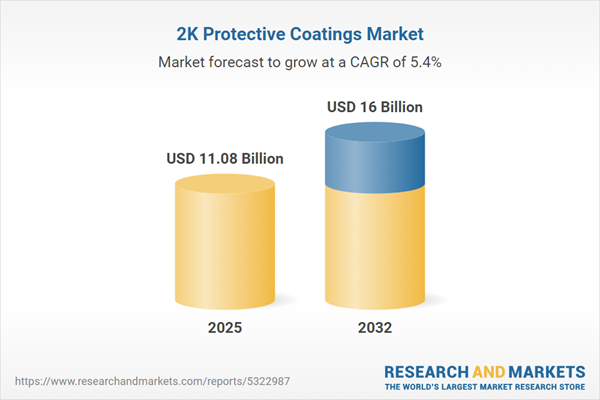Speak directly to the analyst to clarify any post sales queries you may have.
Senior executives in the 2K Protective Coatings Market face dynamic challenges as regulatory compliance, sustainability imperatives, and modernization reshape competitive priorities. Rapid shifts in regional and global directives are prompting leaders to re-evaluate their operational strategies, invest in agile supply chains, and maintain a clear vision for innovation across products and processes.
Market Snapshot: Key Drivers in the 2K Protective Coatings Market
The global 2K Protective Coatings Market is poised for robust, sustained growth through 2032, driven by a solid compound annual growth rate forecast for 2024 and 2025. Increasing regulatory demands—particularly those targeting safety and compliance—are changing how manufacturing organizations approach investment and strategy. Environmental considerations now steer new product development, as businesses prioritize sustainable solutions and adapt their portfolios to accommodate novel coating technologies. This focus on advanced, multifunctional coatings is helping companies better protect critical infrastructure and assets in diverse conditions, reinforcing the market’s trajectory.Scope & Segmentation: 2K Protective Coatings Market Analysis
- Resin Types: Acrylics, alkyds, epoxy systems, polyesters, and polyurethanes are tailored for sector-specific requirements and to ensure alignment with compliance mandates. These resins offer varied performance attributes, meeting operational expectations across regulated industries.
- End Use Industries: Automotive, construction infrastructure, industrial manufacturing, marine, and oil & gas require coatings engineered for corrosion resistance, longer service life, and consistent functioning in rigorous environments.
- Application Types: Solutions are designed to serve both maintenance repair and new construction, supporting asset performance and safeguarding productivity across legacy and modern facilities.
- Technology Types: Powder-based, solvent-based, and water-based coatings allow project teams to leverage application methods suited to regional laws and performance needs, offering flexibility without compromising compliance.
- Sales Channels: Direct sales, distribution partners, and online retail outlets ensure procurement can be adapted to a project’s scope, timeline, and regional logistics.
- Cure Mechanisms: Ambient, thermal, and UV cure options empower organizations to match coating systems to site conditions and optimize application efficiency.
- Packaging Types: Liquid and powder offerings are available to streamline transport, storage, and on-site handling in diverse operational contexts.
- Regions & Countries: Americas, Europe, Middle East & Africa, and Asia-Pacific, with the United States, Germany, China, India, and Brazil serving as focal points due to differing compliance regimes, investment levels, and market strategies.
- Competitive Landscape: PPG Industries, The Sherwin-Williams Company, Akzo Nobel N.V., BASF SE, Axalta Coating Systems, RPM International, Nippon Paint Holdings, Kansai Paint, Hempel, and Jotun lead with technology-focused portfolios and collaborative R&D initiatives, strengthening sector innovation and customer alignment.
Key Takeaways for Senior Decision-Makers
- Advances in resin chemistry and application technologies enable longer-lasting asset protection, reducing lifecycle costs in demanding environments.
- Packaging flexibility and strengthened logistics allow project teams to efficiently manage supply chains and support widely distributed workloads.
- The adoption of waterborne, high-solids, and UV-curable coatings aligns sustainability agendas and regulatory compliance, enabling organizations to future-proof materials selection.
- Digital technology integration bolsters analytics, transparency, and process control, empowering teams to manage multi-facility operations with greater confidence.
- Localized sourcing and adaptable manufacturing models provide rapid adaptation to shifting trade policies or regulatory developments, boosting overall supply chain resilience.
- Collaboration between suppliers, technical experts, and end-users drives continuous product improvement, making it possible to rapidly address evolving market requirements.
Tariff Impact: Manufacturing and Trade Considerations
Changes to United States tariff policies have led organizations to examine sourcing and supply strategies, putting a premium on domestic production and regional investments. This realignment improves procurement adaptability and forges more resilient supply partnerships, managing the risks of trade shifts and supporting consistent operations.
Methodology & Data Sources
This report combines current quantitative data, regulatory evaluation, and feedback from industry professionals in the 2K Protective Coatings Market. Primary data collection is enhanced through proprietary commercial intelligence and specialist insights, providing a sound basis for proactive planning among senior decision-makers.
Why This Report Matters
- Delivers actionable, market-specific insights to support the identification and pursuit of emerging opportunities.
- Clarifies the growing complexities facing operational and compliance teams, equipping organizations to mitigate risk in a landscape of evolving regulations and sustainability priorities.
- Strengthens supply chain planning and continuity strategies, supporting stable operation and risk management within the protective coatings sector.
Conclusion
This analysis gives decision-makers the perspectives needed to elevate compliance, build operational resilience, and support strategies tailored for the evolving 2K Protective Coatings Market.
Additional Product Information:
- Purchase of this report includes 1 year online access with quarterly updates.
- This report can be updated on request. Please contact our Customer Experience team using the Ask a Question widget on our website.
Table of Contents
3. Executive Summary
4. Market Overview
7. Cumulative Impact of Artificial Intelligence 2025
Companies Mentioned
The companies profiled in this 2K Protective Coatings market report include:- PPG Industries, Inc.
- The Sherwin-Williams Company
- Akzo Nobel N.V.
- BASF SE
- Axalta Coating Systems Ltd.
- RPM International Inc.
- Nippon Paint Holdings Co., Ltd.
- Kansai Paint Co., Ltd.
- Hempel A/S
- Jotun A/S
Table Information
| Report Attribute | Details |
|---|---|
| No. of Pages | 180 |
| Published | October 2025 |
| Forecast Period | 2025 - 2032 |
| Estimated Market Value ( USD | $ 11.08 Billion |
| Forecasted Market Value ( USD | $ 16 Billion |
| Compound Annual Growth Rate | 5.3% |
| Regions Covered | Global |
| No. of Companies Mentioned | 11 |









